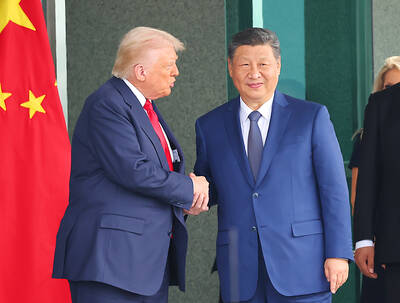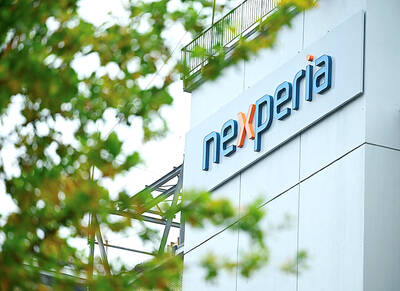China, charting a course of more modest economic growth and mild inflation, yesterday forecast a US$38.6 billion budget deficit this year as it shifts resources to help an impoverished countryside catch up with wealthier cities.
China's development chief, Ma Kai, told the National People's Congress he aimed to keep the world's sixth-biggest economy from being roiled by "big ups and downs."
Ma, who heads the State Development and Reform Commission, a powerful ministry in charge of steering China's breakneck economy, targeted economic growth of around 7 percent last year, a more modest pace than the 9.1 percent pace last year.
There was no hint that China would move soon to revalue its fixed currency, a source of friction with large trade partners like the US who say it gives China an unfair trade advantage.
In laying out the annual budget, Finance Minister Jin Renqing said spending would rise 7 percent and that stimulus bonds once used for public works would be used to boost healthcare, education and other services in the vast countryside.
The rural aid was welcomed with open relief by some of the nearly 3,000 delegates attending the 10-day congress, such as Lin Dongchi, a teacher from China's impoverished southern region of Guangxi.
"We really need this money," Lin, her voice cracking with emotion, said after Jin delivered his speech in the cavernous Great Hall of the People bordering Tiananmen Square.
China, which has issued special bonds every year since the 1997 Asian financial crisis, planned to issue 110 billion yuan worth this year, down 20 percent from last year, Jin said.
The ruling Communist Party fears that a widening wealth gap caused as cities and coastal areas race ahead of the backward hinterland could undermine its authority over the country's 1.3 billion people.
"The government is now stressing a balance between growth and social development. The countryside has developed more slowly and they need more subsidies," said Xie Weihe, a Beijing professor who is a member of an advisory body to parliament.
This year's congress has kicked off with a string of officials signalling an easing of an economy that has quickly become a source of global fascination as it suctions up materials and spews out cheap exports.
Premier Wen Jiabao on Friday vowed to cool off the economy and help hundreds of millions of farmers who are angry at stagnant living standards, corruption and lack of basic services.
But the airing of grievances in China goes only so far.
Plainclothes police dragged one man away from the hall's east gate yesterday after he tried to unveil a placard. It was unclear what he was protesting against, but petitioners from around China come to the capital each year to air grievances.
Jin predicted government expenditure of 2.68 trillion yuan, up 7 percent from last year. That would be nearly 320 billion yuan more than expected revenue, but also mark the first time in several years the deficit has not widened.
"Currently there is a certain uncertainty in global economic development, and the foundation for the sustained development of China's economy is not too stable," Jin said, explaining more deficit spending by the world's fastest-growing major economy.
To help fund this year's budget shortfall and repay old debt, Jin outlined plans to issue 702 billion yuan in treasury bonds this year, about 14 percent more than last year's planned issue of 615 billion yuan.
Ma's outline highlighted the peculiarities of China, where torrid economic growth sits alongside rising unemployment.
Ma said he expected joblessness to rise this year, to 4.7 percent from 4.3 percent last year. Millions in China have been thrown out of work each year as inefficient state companies shed excess workers.
Ma said China aims to check inflation at three percent and cap money supply growth at around 17 percent, a move meant to staunch a flood of money that helped push annual inflation to 3.2 percent in January, the highest level in nearly seven years.
Outlining other economic targets, Ma said China would work to "perfect the exchange rate mechanism" of the yuan while keeping the currency -- pegged at about 8.28 yuan to the US dollar -- basically stable.
Total foreign trade was targeted for an 8 percent rise, Ma said without detailing exports and imports. Last year, China's exports jumped nearly 35 percent. Imports soared almost 40 percent.

Nissan Motor Co has agreed to sell its global headquarters in Yokohama for ¥97 billion (US$630 million) to a group sponsored by Taiwanese autoparts maker Minth Group (敏實集團), as the struggling automaker seeks to shore up its financial position. The acquisition is led by a special purchase company managed by KJR Management Ltd, a Japanese real-estate unit of private equity giant KKR & Co, people familiar with the matter said. KJR said it would act as asset manager together with Mizuho Real Estate Management Co. Nissan is undergoing a broad cost-cutting campaign by eliminating jobs and shuttering plants as it grapples

PERSISTENT RUMORS: Nvidia’s CEO said the firm is not in talks to sell AI chips to China, but he would welcome a change in US policy barring the activity Nvidia Corp CEO Jensen Huang (黃仁勳) said his company is not in discussions to sell its Blackwell artificial intelligence (AI) chips to Chinese firms, waving off speculation it is trying to engineer a return to the world’s largest semiconductor market. Huang, who arrived in Taiwan yesterday ahead of meetings with longtime partner Taiwan Semiconductor Manufacturing Co (TSMC, 台積電), took the opportunity to clarify recent comments about the US-China AI race. The Nvidia head caused a stir in an interview this week with the Financial Times, in which he was quoted as saying “China will win” the AI race. Huang yesterday said

TEMPORARY TRUCE: China has made concessions to ease rare earth trade controls, among others, while Washington holds fire on a 100% tariff on all Chinese goods China is effectively suspending implementation of additional export controls on rare earth metals and terminating investigations targeting US companies in the semiconductor supply chain, the White House announced. The White House on Saturday issued a fact sheet outlining some details of the trade pact agreed to earlier in the week by US President Donald Trump and Chinese President Xi Jinping (習近平) that aimed to ease tensions between the world’s two largest economies. Under the deal, China is to issue general licenses valid for exports of rare earths, gallium, germanium, antimony and graphite “for the benefit of US end users and their suppliers

Dutch chipmaker Nexperia BV’s China unit yesterday said that it had established sufficient inventories of finished goods and works-in-progress, and that its supply chain remained secure and stable after its parent halted wafer supplies. The Dutch company suspended supplies of wafers to its Chinese assembly plant a week ago, calling it “a direct consequence of the local management’s recent failure to comply with the agreed contractual payment terms,” Reuters reported on Friday last week. Its China unit called Nexperia’s suspension “unilateral” and “extremely irresponsible,” adding that the Dutch parent’s claim about contractual payment was “misleading and highly deceptive,” according to a statement